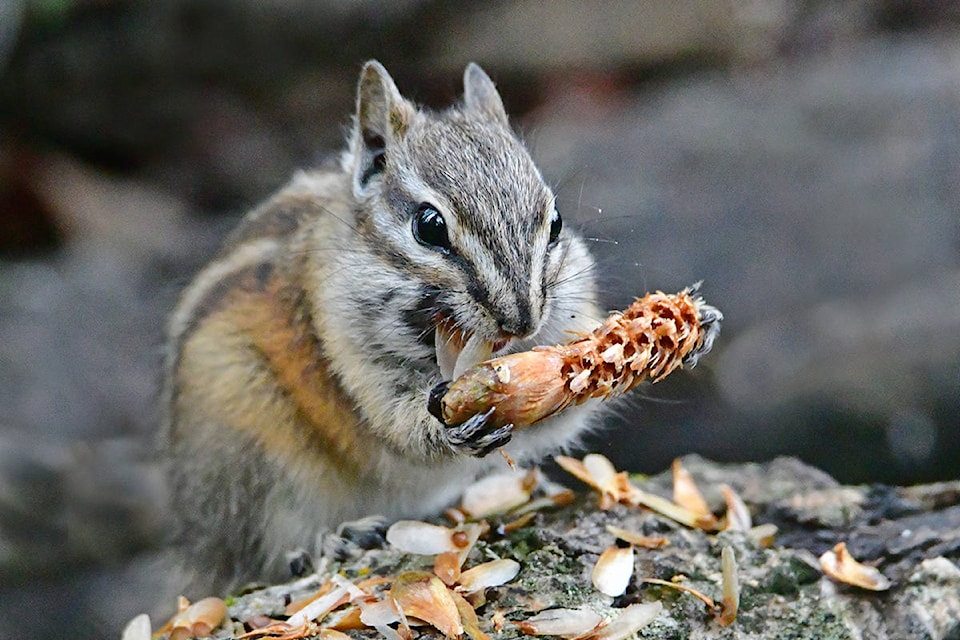A recent visit to the Nordegg area has rekindled my interest in Least Chipmunks. While there, I was able to spend a bit of time one sunny afternoon in the company of a chipmunk that was tackling some dandelion seed heads. I was amazed by its energy, the incredible dexterity of its tiny fingers, and the speed at which it ripped off the seeds.
Chipmunks can be distinguished from other squirrels by their small size, a pattern of five dark and four pale stripes down their backs, and alternating stripes on their faces. There are three species in Alberta but two (Yellow-pine and Red-tailed) are limited to the mountainous areas of the province.
Least Chipmunks eat nuts, seeds, leaves, grasses, flowers, insects and fungi. At backyard bird feeding stations, they will readily devour sunflower seeds and, if they happen upon a bird nest in the forest, will raid it. What they don’t eat on the spot, they gather in their large cheek pouches and pack off to store. They will horde bits of food in many different locations. This practice, called scatter-hording, hides the food from the prying eyes of other animals, including other chipmunks, and serves to ensure that numerous larder locations can be accessed during lean times. Unbeknownst to the chipmunks, this behaviour also serves to enhance forest biodiversity because some of the stored seeds inevitably germinate.
Least Chipmunks are diurnal, retreating to their snug underground burrows or tree cavities at night. They do hibernate in the winter, but instead of relying on stored fat to survive, they spend weeks in the fall filling up their winter burrows with massive stores of food. They dig these winter dens, which consist of one main passageway and one sleeping chamber, in the late summer. They will wake up periodically during the winter to feed from their well-stocked pantries.
While watching a pair of chipmunks a few summers ago at the old Nordegg mine site, I observed that they would regularly touch noses. Apparently sniffing is one of the many ways that chipmunks communicate with each other. Nonaggressive encounters involve nose touching and cheek/neck sniffing while flattened ears, fluffed tails and jerky body movements are displayed if the encounter is aggressive. Like other mammals, they will also sniff each other’s rears to obtain chemical information and display other typical mammalian postures to signify aggression, dominance or submission. They aren’t especially vocal, but will cry out if pursued by a predator, apparently willing to sacrifice their own life to warn others of grave danger. Interestingly, in areas where their ranges overlap with woodchucks, they will respond to the woodchucks’ alarm calls. Woodchucks also recognize the chipmunks’ alarm calls but – being larger and thus less vulnerable – don’t usually pay them much heed.
I also observed that the Nordegg chipmunks scampered around on the old concrete foundations, stopping occasionally to lick at the substrate. It is likely that the weathered cement provided some type of appealing salt or mineral.
The Least Chipmunk has a wide distribution across Alberta, but I rarely see them except in the west country. It is likely that local populations across the agricultural areas of the province have been wiped out by habitat destruction and cats. If you share your yard or farm with these remarkable little wild neighbours, I would appreciate hearing from you. It would be interesting to get details on their local distribution.
Myrna Pearman is the Biologist and Site Services Manager at Ellis Bird Farm. She can be reached at mpearman@ellisbirdfarm.ca.
